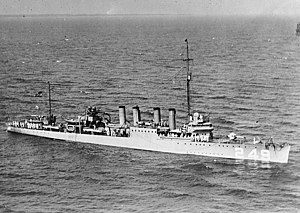USS Hopkins (DD-249)
 |
|
| History | |
|---|---|
|
|
|
| Namesake: | Esek Hopkins |
| Builder: | New York Shipbuilding |
| Laid down: | 30 July 1919 |
| Launched: | 26 June 1920 |
| Commissioned: | 21 March 1921 |
| Decommissioned: | 21 December 1945 |
| Struck: | 8 January 1946 |
| Fate: | sold for scrapping 8 November 1946 |
| General characteristics | |
| Class and type: | Clemson-class destroyer |
| Displacement: | 1,190 tons |
| Length: | 314 feet 5 inches (95.83 m) |
| Beam: | 31 feet 8 inches (9.65 m) |
| Draft: | 9 feet 3 inches (2.82 m) |
| Propulsion: |
|
| Speed: | 35 knots (65 km/h) |
| Range: | 4,900 nm @ 15 kn (9,100 km @ 28 km/h) |
| Complement: | 101 officers and enlisted |
| Armament: | 4 x 4 in (100 mm) guns, 1 x 3 in (76 mm) gun, 12 x 21 inch (533 mm) tt. |
USS Hopkins (DD-249/DMS-13) was a Clemson-class destroyer in the United States Navy during World War II. She was the third ship named USS Hopkins and the third named for Esek Hopkins.
Hopkins was launched 26 June 1920 by the New York Shipbuilding Corporation; sponsored by Miss Sarah Babbitt, a descendant of Esek Hopkins; and commissioned 21 March 1921 at Philadelphia, Lieutenant Commander C. A. Bailey commanding.
After shakedown Hopkins arrived at Newport, Rhode Island, 31 May for battle practice training during the summer. In November, she was assigned to Destroyer Squadron 15 for tactical training with the Atlantic Fleet along the East Coast.
Hopkins sailed from Hampton Roads 2 October 1922, and reached Constantinople 22 October for duty in Turkish waters. She protected American interests and cooperated with the relief mission in the Near East, ranging to Beirut, Jaffa, and Smyrna. She departed Constantinople 18 May 1923 for New York, arriving 12 June. For the next 7 years, Hopkins operated out of New England ports in the summer, Charleston, South Carolina, in the winter, and the Caribbean Sea in the spring. During the spring of 1930, Hopkins participated in force battle practice with aircraft.
...
Wikipedia
